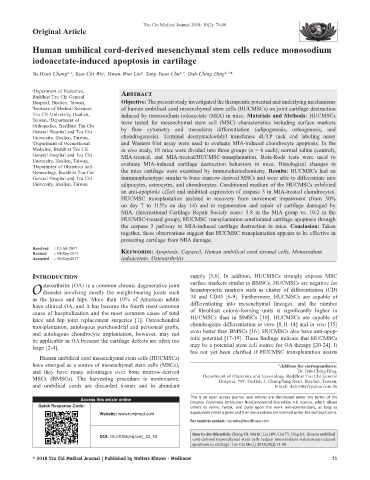Page 103 - Human Umbilical Cord Mesenchymal Stem Cells
P. 103
Tzu Chi Medical Journal 2018; 30(2): 71-80
Original Article
Human umbilical cord-derived mesenchymal stem cells reduce monosodium
iodoacetate-induced apoptosis in cartilage
Yu‑Hsun Chang , Kun‑Chi Wu , Hwan‑Wun Liu , Tang‑Yuan Chu , Dah‑Ching Ding *
c
d
b, e
b, e
a, b
a Department of Pediatrics, Abstract
Buddhist Tzu Chi General
Hospital, Hualien, Taiwan, Objective: The present study investigated the therapeutic potential and underlying mechanisms
b Institute of Medical Sciences, of human umbilical cord mesenchymal stem cells (HUCMSCs) on joint cartilage destruction
Tzu Chi University, Hualien, induced by monosodium iodoacetate (MIA) in mice. Materials and Methods: HUCMSCs
Taiwan, Department of were tested for mesenchymal stem cell (MSC) characteristics including surface markers
c
Orthopedics, Buddhist Tzu Chi
General Hospital and Tzu Chi by flow cytometry and mesoderm differentiation (adipogenesis, osteogenesis, and
University, Hualien, Taiwan, chondrogenesis). Terminal deoxynucleotidyl transferase dUTP nick end labeling assay
d Department of Occupational and Western blot assay were used to evaluate MIA-induced chondrocyte apoptosis. In the
Medicine, Buddhist Tzu Chi in vivo study, 18 mice were divided into three groups (n = 6 each); normal saline (control),
General Hospital and Tzu Chi MIA-treated, and MIA-treated/HUCMSC-transplantation. Rota-Rods tests were used to
University, Hualien, Taiwan,
e Department of Obstetrics and evaluate MIA-induced cartilage destruction behaviors in mice. Histological changes in
Gynecology, Buddhist Tzu Chi the mice cartilage were examined by immunohistochemistry. Results: HUCMSCs had an
General Hospital and Tzu Chi immunophenotype similar to bone marrow-derived MSCs and were able to differentiate into
University, Hualien, Taiwan adipocytes, osteocytes, and chondrocytes. Conditioned medium of the HUCMSCs exhibited
an anti-apoptotic effect and inhibited expression of caspase 3 in MIA-treated chondrocytes.
HUCMSC transplantation assisted in recovery from movement impairment (from 30%
on day 7 to 115% on day 14) and in regeneration and repair of cartilage damaged by
MIA. (International Cartilage Repair Society score: 3.8 in the MIA group vs. 10.2 in the
HUCMSC-treated group); HUCMSC transplantation ameliorated cartilage apoptosis through
the caspase 3 pathway in MIA-induced cartilage destruction in mice. Conclusion: Taken
together, these observations suggest that HUCMSC transplantation appears to be effective in
protecting cartilage from MIA damage.
Received : 12-Jul-2017 Keywords: Apoptosis, Capase3, Human umbilical cord stromal cells, Monosodium
Revised : 04-Sep-2017
Accepted : 08-Sep-2017 iodoacetate, Osteoarthritis
Introduction supply [5,6]. In addition, HUCMSCs strongly express MSC
steoarthritis (OA) is a common chronic degenerative joint surface markers similar to BMSCs. HUCMSCs are negative for
Odisorder involving mostly the weight-bearing joints such hematopoietic markers such as cluster of differentiation (CD)
as the knees and hips. More than 10% of American adults 34 and CD45 [6-9]. Furthermore, HUCMSCs are capable of
have clinical OA, and it has become the fourth most common differentiating into mesenchymal lineages, and the number
cause of hospitalization and the most common cause of total of fibroblast colony-forming units is significantly higher in
knee and hip joint replacement surgeries [1]. Osteochondral HUCMSCs than in BMSCs [10]. HUCMSCs are capable of
transplantation, autologous perichondrial and periosteal grafts, chondrogenic differentiation in vitro [8,11-14] and in vivo [15]
and autologous chondrocyte implantation, however, may not even better than BMSCs [16]. HUCMSCs also have anti-apop-
be applicable in OA because the cartilage defects are often too totic potential [17-19]. These findings indicate that HUCMSCs
large [2-4]. may be a potential stem cell source for OA therapy [20-24]. It
has not yet been clarified if HUCMSC transplantation assists
Human umbilical cord mesenchymal stem cells (HUCMSCs)
have emerged as a source of mesenchymal stem cells (MSCs), *Address for correspondence:
and they have many advantages over bone marrow-derived Dr. Dah‑Ching Ding,
MSCs (BMSCs). The harvesting procedure is noninvasive, Department of Obstetrics and Gynecology, Buddhist Tzu Chi General
Hospital, 707, Section 3, Chung‑Yang Road, Hualien, Taiwan.
and umbilical cords are discarded tissues and in abundant E‑mail: dah1003@yahoo.com.tw
Access this article online This is an open access journal, and articles are distributed under the terms of the
Creative Commons Attribution-NonCommercial-ShareAlike 4.0 License, which allows
Quick Response Code: others to remix, tweak, and build upon the work non-commercially, as long as
Website: www.tcmjmed.com appropriate credit is given and the new creations are licensed under the identical terms.
For reprints contact: reprints@medknow.com
DOI: 10.4103/tcmj.tcmj_23_18 How to cite this article: Chang YH, Wu KC, Liu HW, Chu TY, Ding DC. Human umbilical
cord-derived mesenchymal stem cells reduce monosodium iodoacetate-induced
apoptosis in cartilage. Tzu Chi Med J 2018;30(2):71-80.
© 2018 Tzu Chi Medical Journal | Published by Wolters Kluwer ‑ Medknow 71

